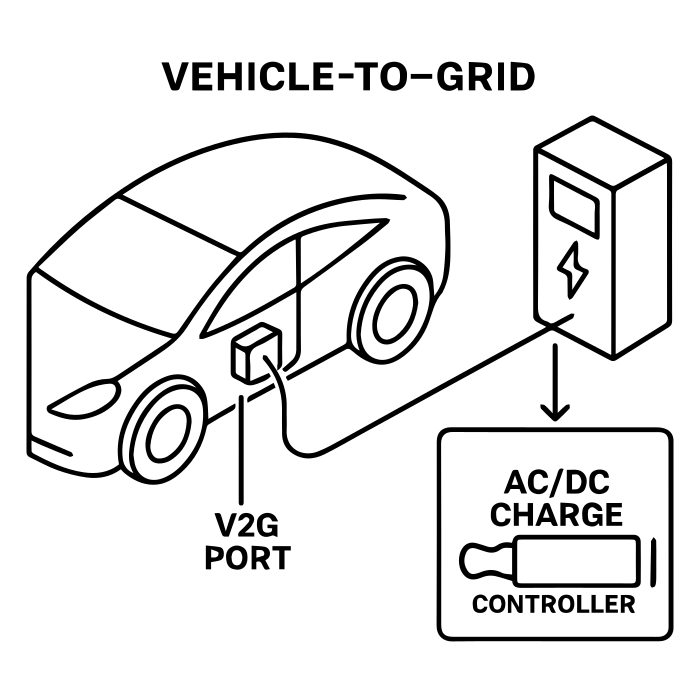Electric mobility is transforming: in addition to fast charging and reduced emissions, vehicles can now integrate into home and grid energy systems, taking on the role of a storage resource.
Two-way charging technology turns the electric vehicle into a smart energy storage system capable of powering the home(Vehicle-to-Home, V2H) and contributing to the stability of the national grid(Vehicle-to-Grid, V2G).
In this article we will analyze the principles of operation, technical and regulatory requirements, the state of the art in Italy, and the prospects for the development of this innovation that is destined to reshape the relationship between car, home, and electric grid.
What is two-way charging
Unlike traditional charging, which involves a unidirectional flow of energy-from the grid to the car-a bidirectional system allows energy to move in both directions: the vehicle can not only draw energy, but is also able to return it. This process is made possible by the ability to handle current conversion.
Because the grid delivers energy in alternating current (AC) and batteries operate in direct current (DC), bidirectional systems integrate reversible AC/DC converters that can handle both charging and delivery to homes or the grid. The energy thus extracted from the battery can be directed to two main destinations.
Vehicle-to-Home (V2H): benefits and practical applications
In the Vehicle-to-Home scenario, the energy stored in the vehicle’s battery can be used to power the home or building to which it is connected. V2H makes it possible to take advantage of the cheapest tariff bands, optimize self-consumption, and use the vehicle as an emergency power reserve in case of a power outage.

Vehicle-to-Grid (V2G): role and potential in the grid
Vehicle-to-Grid configures electric vehicles as distributed storage units: they can absorb excess renewable energy and return it to the grid during peak demand, contributing to the stability of the electricity system.
Technical requirements for V2H and V2G
In order to exploit the full potential of bidirectional charging, whether in its domestic (V2H) or network (V2G) sense, certain technical requirements must be met:
- Compatible vehicle with bidirectional charging
- Two-way wallbox (DC): devices that comply with the ISO 15118-20 standard
- Bidirectional meter and inverter compatible
- Approval and integration with DSO (for V2G)
The first essential element for compatibility with V2H/V2G is an electric vehicle with the necessary hardware and software technology to manage the energy outflow; not all current models support this functionality (some known examples include the Nissan Leaf, Mitsubishi Outlander PHEV, Kia EV9, and Renault Scenic E-Tech 2024);
The second crucial component is a bidirectional wallbox, which operates on direct current(DC). This advanced charging station acts as an intermediary between the vehicle and the grid and must comply with the ISO 15118-20 communication standard, the protocol that governs the exchange of data between the vehicle and the charging infrastructure.
Implementation requires adequate system-level preparation. V2H assumes bidirectional meter and bidirectional inverter compatible to manage energy within the home.
V2G requires approval and integration of the system with theDistribution System Operator(DSO ), i.e., the power grid operator, a key step to date that has not yet been widely deployed and standardized in Italy.
Two-way charging in Italy: state of the art 2025
Although already mature internationally, in Italy the deployment of bidirectional technology is still limited and confined to specific contexts: pilot projects coordinated by operators such as ENEL X, Terna and Next Charge, aimed at defining operating models and market rules.
Truly operational infrastructure requires the use of bidirectional DC wallboxes that are not compatible with the more common and widespread alternating current(AC) wallboxes used in residential settings today.
At present, V2H mode is the most affordable technology for the home user, finding application mainly as an emergency backup system in the event of a network outage.
Limits and challenges to the deployment of two-way charging
Despite the clear advantages, the adoption of bidirectional charging faces some critical issues that limit its widespread adoption. The main obstacle is economic: bidirectional wallboxes cost up to three times more than a traditional charger. Added to this is the limited compatibility, restricted to prepared vehicle models.
At the system level, the main challenge is regulatory. Theabsence of clear and standardized regulation for V2G prevents the definition of integration arrangements and economic remuneration for energy returned to the grid by users, blocking the full development of the market.
One aspect that should not be underestimated is the potential impact on battery pack wear and tear. Although current studies show that additional charge-discharge cycles (V2G/V2H) have little effect, it is imperative that processes involvingbattery use as home storage be managed and regulated through advanced software.
Silla solutions and future developments
A recurring question is: is it possible to use common wallboxes in Alternating Current for bidirectional charging (AC wallbox) ?
At present, the answer is no: although international standards also theoretically provide for bidirectionality in AC, all real and operational applications on the market today employ only Direct Current (DC) devices.
To fill this gap, Silla Industries is developing a bidirectional wallbox designed to natively support both V2H and V2G modes, and fully compliant with the ISO 15118-20 standard. The project is aligned with the European AFIR and RED III directives and the planned technical roadmaps for smart electric mobility
This solution, which can be integrated into smart charging ecosystems thanks to the OCPP protocol, will offer Silla users (e.g., of the Prism line) the ability to natively evolve toward bidirectionality.
Follow developments on our blog for updates and analysis on emerging technologies.

